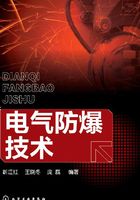
2.3 典型场所爆炸危险区域划分
除上述通用爆炸危险区域划分外,我国国家标准中亦对部分装置典型场所的爆炸危险区域划分进行了规定,并绘制了典型场所内建构筑物、装置、设备、设施的爆炸危险区域划分示例图。具体情况如下。
2.3.1 氢气站
《氢气站设计规范》(GB 50177—2005)在《爆炸危险环境电力装置设计规范》规定的基础上,考虑氢气密度小、易扩散的特性,对氢气站内制氢间、氢气纯化间、氢气压缩机间、氢气灌瓶间等有爆炸危险房间,氢气排放口,氢气站的室外制氢设备、氢气罐等爆炸危险区域的划分进行了规定。
具体示例详见图2-12、图2-13。

图2-12 氢气站厂房内爆炸危险区域划分图

图2-13 氢气站内的室外制氢设备、氢气罐爆炸危险区域划分图
2.3.2 汽车加油加气站
《汽车加油加气站设计与施工规范》(GB 50156—2012,2014年版)在《爆炸危险环境电力装置设计规范》规定的基础上,对汽油加油机、埋地卧式汽油储罐、LPG加气机、埋地LPG储罐、地上LPG储罐等爆炸危险区域的划分进行了规定。
具体示例详见图2-14~图2-30。

图2-14 汽油加油机爆炸危险区域划分图

图2-15 汽油的地面油罐、油罐车和密闭卸油口爆炸危险区域划分图

图2-16 埋地卧式汽油储罐爆炸危险区域划分图

图2-17 LPG加气机爆炸危险区域划分图

图2-18 埋地LPG储罐爆炸危险区域划分图

图2-19 地上LPG储罐爆炸危险区域划分图

图2-20 露天或棚内设置的LPG泵、压缩机、阀门、法兰或类似附件爆炸危险区域划分图

图2-21 LPG压缩机、泵、法兰、阀门或类似附件的房间爆炸危险区域划分图

图2-22 CNG和LNG加气机爆炸危险区域划分图

图2-23 室外或棚内CNG储气瓶(组)、储气井、车载储气瓶的爆炸危险区域划分图

图2-24 CNG压缩机、阀门、法兰或类似附件的房间爆炸危险区域划分图

图2-25 露天(棚)设置的CNG压缩机组、阀门、法兰或类似附件爆炸危险区域划分图

图2-26 存放CNG储气瓶(组)的房间爆炸危险区域划分图

图2-27 地上LNG储罐的爆炸危险区域划分图

图2-28 半地下LNG储罐的爆炸危险区域划分图

图2-29 地下LNG储罐的爆炸危险区域划分图

图2-30 露天设置的LNG泵、空温式LNG气化器、
阀门及法兰的爆炸危险区域划分图
2.3.3 城镇燃气系统
《城镇燃气设计规范》(GB 50028—2006)中规定了制气车间、煤气净化车间主要生产场所爆炸危险区域等级。具体情况详见表2-7、表2-8。
表2-7 制气车间主要生产场所爆炸危险区域等级(部分)

注:除发生炉煤气相对密度大于0.75外,其他煤气相对密度均小于0.75。
表2-8 煤气净化车间主要生产场所爆炸危险区域等级(部分)

注:所有室外区域不应整体划分危险区域,应按照现行国家标准GB 50058《爆炸危险环境电力装置设计规范》的规定要求,以释放源和释放半径划分爆炸危险区域。
《城镇燃气设计规范》规定了对燃气输配系统生产区域用电场所、液化石油气站用电场所等爆炸危险区域的等级和范围划分。
燃气输配系统生产区域用电场所爆炸危险区域划分具体示例详见图2-31~图2-36;液化石油气站用电场所爆炸危险区域划分详见图2-37~图2-39。

图2-31 露天设置的固定容积储气罐爆炸危险区域划分图

图2-32 低压储气罐进出气管阀门间爆炸危险区域划分图

图2-33 通风良好的压缩机室、调压室、计量室等生产用房爆炸危险区域划分图

图2-34 露天设置的工艺装置区爆炸危险区域划分图

图2-35 地下调压室和地下阀室的爆炸危险区域划分图

图2-36 城镇无人值守的燃气调压室爆炸危险区域划分图

图2-37 通风良好的生产性建筑爆炸危险区域划分图

图2-38 地上液化石油气储罐区爆炸危险区域划分图

图2-39 铁路槽车和汽车槽车装卸口处爆炸危险区域划分图
2.3.4 涂装作业浸涂工艺
《涂装作业安全规程浸涂工艺安全》(GB 17750—2012)在《爆炸危险环境电力装置设计规范》规定的基础上,分别对无抑制蒸气或通风的浸涂作业、有抑制蒸气和通风的浸涂作业、封闭浸涂作业和敞开容器的爆炸危险区域划分进行了规定。
具体示例详见图2-40~图2-43。

图2-40 无抑制蒸气或通风的浸涂作业爆炸危险区域划分图

图2-41 有抑制蒸气或通风的浸涂作业爆炸危险区域划分图

图2-42 封闭浸涂作业爆炸危险区域划分图

图2-43 敞开容器爆炸危险区域划分图
2.3.5 液化天然气(LNG)汽车加气站
《液化天然气(LNG)汽车加气站技术规范》(NB/T 1001—2011)在《爆炸危险环境电力装置设计规范》规定的基础上,考对LNG加气机、地上LNG储罐、露天设置的LNG泵、露天设置的空温式LNG气化器、输送易燃物质的管道上的阀门及法兰等爆炸危险区域的划分进行了规定。
具体示例详见图2-44~图2-46。需要指出的是,图2-44与图2-22相似,需根据罩棚高度和长度来准确确定爆炸危险区域范围。

图2-44 LNG加气机爆炸危险区域划分图

图2-45 地上LNG储罐爆炸危险区域划分图

图2-46 露天设置的LNG泵爆炸危险区域划分图
综上所述,各种爆炸危险区域划分示例均是在一定条件下划分的,虽能起到一定的指导性作用,但仍不能全面解决实际工作中遇到的问题。在实际工作中,专业技术人员必须考虑实际场所的特点,注意各种不同情况的特殊细节,结合实际工作经验,认真分析,以得到更为准确的区域划分及其范围。
2.3.6 粮食加工、储运
《粮食加工、储运系统粉尘防爆安全规程》(GB 17440—2008)规定了粮食加工、储运系统粉尘爆炸危险区域(此标准不适用于油脂浸出车间和粮食干燥装备)。《粮食立筒仓粉尘防爆安全规范》(AQ 4229—2013)和《粮食平房仓粉尘防爆安全规范》(AQ 4230—2013)在GB 17440的基础上,对粮食立筒仓、平房仓的爆炸危险区域进行了更详细的划分。本节基于上述标准归纳总结了粮食加工、储运系统粉尘爆炸危险区域划分表,具体详见表2-9。
表2-9 粮食加工、储运系统粉尘爆炸危险区域划分①

续表

①本表采用以厂房建筑为单位,划定粮食粉尘爆炸性危险区域。
②浅圆仓、料仓参照立筒仓执行。
③墙指无洞孔的砖、轻质材料墙体等。
④在清理积聚的粉尘后,空仓及储存期间的仓为非危险区域,允许使用防尘型设备进行有关作业。
⑤产量不大于100t/h,如果采取有效的粉尘控制措施使作业场所粉尘浓度低于爆炸下限的25%,可以视为22区或非危险区域。